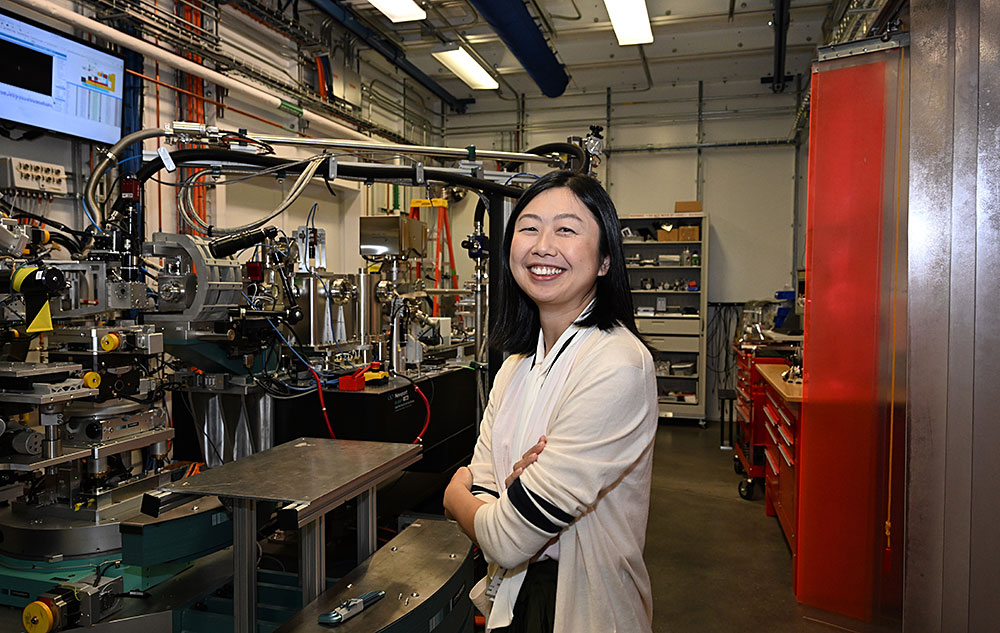Meet Xiaoqian Chen, NSLS-II Beamline Scientist
Xiao leads the quantum materials program at NSLS-II's Coherent Hard X-Ray Scattering beamline
October 10, 2023
Xiaoqian Chen is a physicist and beamline scientist with the complex scattering program at the National Synchrotron Light Source II (NSLS-II), a U.S. Department of Energy (DOE) Office of Science User Facility at DOE’s Brookhaven National Laboratory. At NSLS-II’s Coherent Hard X-ray Scattering (CHX) beamline, she studies materials with quantum behaviors and guides users in their investigations into quantum materials.
You’ve already spent a few years at Brookhaven, starting in 2016. What brought you back to the Laboratory?
My history with the Laboratory goes back to when I was a user at the original National Synchrotron Light Source (NSLS). I was in graduate school, and my group had our own beamline at NSLS, X1B. I was the person maintaining that beamline, so I came to know many people here.
When I became a postdoc, I decided to join the x-ray scattering group in Brookhaven’s Condensed Matter Physics & Materials Science Department because we shared the same research interests and coherent x-ray science was emerging. I joined when the Coherent Soft X-ray Scattering (CSX) beamline at NSLS-II had just achieved first light. I was able to participate in the first experiments there, and that was my postdoc work.
I then took a postdoc position at DOE’s Lawrence Berkeley National Laboratory and worked more on coherent x-ray science. After three years, I was offered a position at CHX to lead the quantum materials program.
What does your role at CHX entail? What kind of research do you do?
My research, in a broad sense, is in the field of condensed matter physics, looking at quantum materials. These are materials that have behaviors that are very heavily guided by quantum mechanical effects. For example, some have superconducting properties, and some have interesting magnetism. With help from my postdoc, I am looking into discovering new quantum effects in materials, and our work is supported by a Laboratory Directed Research and Development (LDRD) grant. Apart from my own research, I prepare an environment at CHX for scientists in our community to perform coherent x-ray experiments and study dynamical properties in their materials.
At CHX, we use coherent x-ray photons to track the dynamics inside materials. We can detect electron dynamics as fast as the nanosecond time scale with our recent detector installation. I’m currently trying to detect and study dynamics in materials that take place at that time scale. The ultimate goal is to find a signature of quantum entanglement. This property is a specific type of interaction between electrons; they show very different behavior from electrons in classical materials.
There are some other new capabilities that we are excited for users to experience. We have added a resonance scattering capability to look at element-specific information. For example, we can look at electrons in specific orbitals. We also added low temperature capability with a new cryostat that can chill samples to 4K. That’s very cold, and it will be very useful for studying quantum materials.
What does a typical day look like for you as the program leader?
When we have users, I usually spend most of the day supporting them. During the remaining time, I am working on my own experiments, writing grants, working on papers, or having meetings with my collaborators. I also make sure to treat myself for sushi lunch once a week.
What do you enjoy about your work?
Working at a user facility is about helping others and not just focusing on your own interests. I like knowing that my knowledge and expertise is assisting other researchers; that is something I appreciate.
I also like the support of the people here; that is a main reason that I joined CHX. There are so many colleagues to talk to and ask for advice.
What do you find to be challenging about your job?
Because we work in a big facility, we get to work on research ideas that are beyond what a single person can do. And that is also encouraged. But this also means that it can be challenging to move fast. It takes time to get your group on board and make sure that everyone has the same goal. You also have to convey the idea at the lab level, and get their support, and that takes time.
Tell us a bit about your life outside of work.
I was born in Shanghai, China, but my family moved to Japan when I was six. So, I grew up in Japan and then came to the U.S. when I was in high school. I visited China every year when I was little, and it has been interesting to see how much it has developed. I appreciate having grown up in different countries. I like to travel, and I think that’s why. I like seeing how people in different countries live.
I have now spent more years in the U.S. than any other country, but I still feel most comfortable with Japanese culture, I think. I still read a lot of news and articles in Japanese and watch Japanese shows. I haven’t been back recently because of the pandemic, but I used to go back often. I still have many friends there.
Brookhaven National Laboratory is supported by the Office of Science of the U.S. Department of Energy. The Office of Science is the single largest supporter of basic research in the physical sciences in the United States and is working to address some of the most pressing challenges of our time. For more information, visit science.energy.gov.
Follow @BrookhavenLab on social media. Find us on Instagram, LinkedIn, Twitter, and Facebook.
2023-21486 | INT/EXT | Newsroom










